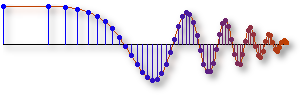
8. IIR Filters

Overview: In chapter 8 the class of infinite-impulse-response (IIR)
filters is introduced. These digital filters involve feedback terms because
past values of the output signal are used to compute the present output.
The terminology "recursive filter" is also used t name these filters. Their
z-Transform system functions are rational functions which have poles
and zeros. Insight into the important properties of these filters comes
directly from the pole-zero representation.
Homework
Labs - MATLAB
| Lab 11: PeZ - The z, n, and ω Domains | The objective for this lab is to build an intuitive understanding of the relationship between the location of poles and zeros in the z-domain, the impulse response h[n] in the n-domain, and the frequency response H(ejω) (the ω-domain). A graphical user interface (GUI) called PeZ was written in MATLAB for doing interactive explorations of the three domains. |
| mp04 - PeZ | In this mini-project you will experiment with PeZ to learn the connection between pole-zero placement and frequency response. Given this information you will redo the Tone Removal Mini-Project using an IIR. |
| mp05: - Note Detection | For this mini project you will write a simple function that listens to a tone and identifies what note it is. [Files] |
| mp06: Simple Song Detection | For this mini project you will write a simple function that listens to a wav file of a simple song and identifies the notes being played. The wav files have some simple songs on which you can practice. [Files] |
| mp07: Swiss Army Knife | You have gotten to the point in your studies that you can understand DSP papers that appear in IEEE publications. The purpose of this project is to read one such paper and reproduce some of its results. |
Demos
 |
8-9,10,12,23,24,26 Pole-Zero plots via PeZ | p210,215,223,233,234,235 - Several figures in Chapter 8 can be easily reproduced by using PeZ, the pole zero editor. |
 |
8-27,28 Digital Filter Design Utility |
p236,237 - Interactively specify and design floating point digital filters.
The software provides a filter design tool for classical design which
allows you to specify a FIR/IIR designs by setting design parameters such as filter type,
sampling frequency, passband/stopband edge frequencies, passband/stopband ripple levels, and stopband
attenuation.
You can select from design methods that include Butterworth, Chebyshev, Inverse Chebyshev, Elliptic, Kaiser Window, Dolph-Chebyshev, and Equi-Ripple. |
 |
7.6 s-plane to z-plane | p506 - See how poles and zeros change position between being plotted on the s-plane and being plotted on the z-plane. Input is either a filter specification or pole/zero locations on the z-plane. |
